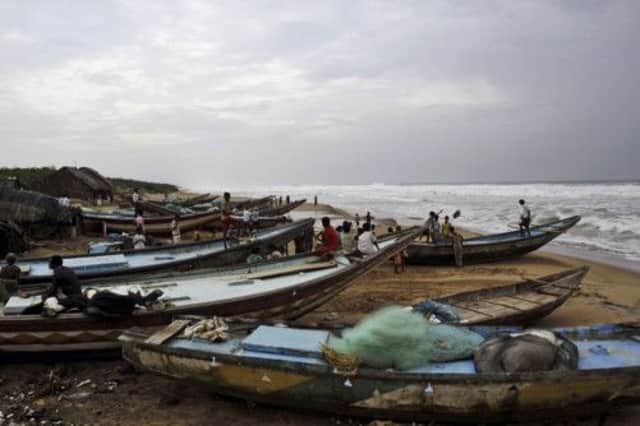India: Tens of thousands flee cyclone’s path


Large waves were pounding beaches in the state of Andhra Pradesh more than a day before cyclone Phailin was due to hit.
Villagers were evacuated to schools in the north of the state and in neighbouring Odisha, while panic buying drove up food prices.
Advertisement
Hide AdAdvertisement
Hide AdSatellite images showed Phailin some 310 miles off the coast in the Bay of Bengal and likely to make landfall last night, with widespread flooding expected.
The images showed the storm covering an area roughly half the size of India. Some forecasters likened its size and intensity to that of hurricane Katrina, which devastated the US Gulf coast and New Orleans in 2005.
Some 260,000 people were moved to safer ground and more were expected to be evacuated by the end of yesterday, authorities in the two states said. Not everybody was willing to leave their homes and belongings, and some villagers on the palm-fringed Andhra Pradesh coast said they had not been told to evacuate.
“Of course I’m scared, but where will I move with my family?” asked Kuramayya, 38, a fisherman from the village of Bandharuvanipeta, close to where the hurricane is expected to make landfall. “We can’t leave our boats behind.”
The Indian Meteorological Department said Phailin would hit between the town of Kalingapatnam in Andhra Pradesh and the major port of Paradip in Odisha and predicted flooding from expected storm surges of about three metres above normal tides.
There was disagreement about the strength of Phailin, although most forecasters expected it to weaken upon reaching the coast. The Indian Meteorological Department described it as a “very severe cyclonic storm” with wind speeds of 130-135mph and resisted upgrading it to a stronger “super cyclone”.
London-based storm tracking service Tropical Storm Risk said Phailin was a super cyclone and placed it in the most intense Category 5 of powerful storms, evoking memories of the devastating 1999 storm when winds reaching speeds of 300kph battered Odisha for 30 hours.
Odisha officials agreed. “Phailin will be no less than the 1999 super cyclone,” Odisha state’s special relief commissioner, Pradeep Kumar Mohapatra, said.
Advertisement
Hide AdAdvertisement
Hide AdHe added half a million people were expected to move to shelters.
This time, the state government said it was better prepared. It broadcast cyclone warnings through loudspeakers and on radio and television as the first winds were felt on the coast and in state capital, Bhubaneswar.
Indian authorities warned of extensive damage to crops, villages and old buildings, as well as disruption of power, water and rail services. Leave for government employees was cancelled.